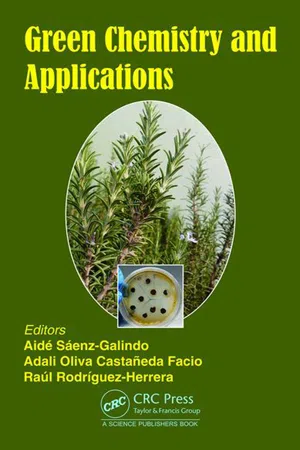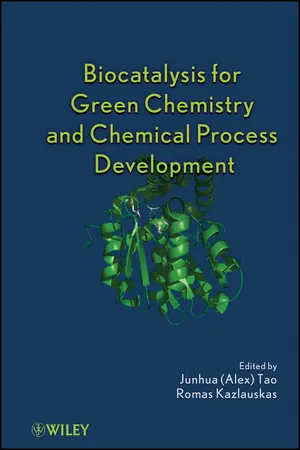Chemistry
Atom Economy
Atom economy is a measure of the efficiency of a chemical reaction. It is calculated by comparing the mass of the desired product to the total mass of all reactants used. A higher atom economy indicates a more efficient reaction with less waste.
Written by Perlego with AI-assistance
Related key terms
Related key terms
1 of 4
Related key terms
1 of 3
4 Key excerpts on "Atom Economy"
- eBook - ePub
- Aide Sáenz-Galindo, Adali Facio, Raul Rodriguez-Herrera, Aide Sáenz-Galindo, Adali Oliva Castañeda Facio, Raul Rodriguez-Herrera(Authors)
- 2020(Publication Date)
- CRC Press(Publisher)
Chapter 2Atom EconomyKunnambeth M. Thulasi1 , Sindhu Thalappan Manikkoth,1 , Manjacheri Kuppadakkath Ranjusha1 , Padinjare Veetil Salija1 Vattakkoval Nisha1 , Shajesh Palantavida2 and Baiju Kizhakkekilikoodayil Vijayan1 *1 Department of Chemistry/Nanoscience, Kannur University, Swami Anandha Theertha Campus, Payyannur, Edat P.O., Kerala-670 327, India.2 Centre for Nano and Materials Science, Jain University, Jakkasandra, Ramanagaram, Karnataka, India.INTRODUCTION
The concept of Atom Economy was developed by Barry M. Trost in 1991. Organic synthesis requires multiple reagents, facilitating agents and solvents to obtain the desired product. At the end of the reaction everything except for the desired product and reagents that can be recycled, like solvents and catalysts, will end up as wastes, mostly hazardous wastes. Conceptually, if the desired product contains all the atoms making up the reagents there will be no waste generated. The concept of Atom Economy can be used to identify synthetic methodologies that will retain the maximum number of atoms from the reactants in the final product and thereby reduce wastage. The Atom Economy concept allows quantification of the efficiency of a reaction with respect to the number of atoms transferred from the reactants to the final desired product (Trost, 1995; Trost, 2002). The concept of Atom Economy can be applied to every synthesis and be used to define new pollution prevention benchmarks (Cann and Dickneider, 2004; Song et al., 2004). Atom Economy calculation, broadly presents a measure of the greenness of a chemical reaction. The commonly used indicator for efficiency of a reaction in organic synthesis is the percentage yield, which neglects mass flow (Cann and Dickneider, 2004). A synthetic chemist records the yield of a particular reaction as percentage yield. The percentage yield can be calculated as - eBook - ePub
- Jeffrey Gaffney, Nancy Marley(Authors)
- 2017(Publication Date)
- Elsevier(Publisher)
It ignores the production of waste products that can be costly or environmentally hazardous. A reaction can have a high percent yield, but result in a lot of waste products. A major concept of both Green Chemistry and Green Engineering encourages process designs that assure the maximum amount of all reactants ending up in the desired product while a minimum amount of waste is produced. With these goals of increasing product yield while at the same time reducing waste and increasing sustainability, industrial processes have begun to include the concept known as Atom Economy along with that of percent yield. Atom Economy is the conversion efficiency of a chemical reaction in terms of all the atoms involved. It is calculated as the ratio of the formula weight of the desired product(s) to the total formula weight of all the reactants multiplied by 100. Atom Economy % = Formula weight of desired product s Formula weight of all reactants × 100 (7) The Atom Economy of the overall reaction for the conversion of iron ore to pig iron in a blast furnace is 45.8%. Any reaction that has an Atom Economy less than 50% is considered to be poor. In addition, this calculation does not take into account the excess reagents used to drive the reactions to completion or the production of waste slag from the limestone flux. Including these waste products would greatly reduce the Atom Economy of the blast furnace process. One of the biggest problems with the use of blast furnaces is the high levels of carbon dioxide produced. Three moles of CO 2 are produced for every two moles of iron. In addition, CO 2 is also formed from the decomposition of the limestone flux. Currently, there are no known reactions that can convert iron ore to pig iron with a better Atom Economy on as high a production scale as the blast furnace. However, some suggested design modifications may result in reductions in energy costs as well as environmental impacts - Marianna Torok(Author)
- 2022(Publication Date)
- Elsevier(Publisher)
It is calculated as the ratio of the molecular weight of the product and the sum of the molecular weights of all substances used in the stoichiometric, balanced equation of a reaction and expressed as a percentile value. 21 Atom Economy is a theoretical descriptor; it is based on the reaction equation only, considering 100% (theoretical) yield. Thus, unexpected byproducts or actual, experimental yields are not factored in. AE is the description of the best possible scenario, however, despite its shortcomings it is a good measure to compare different variations of the same basic reaction using the different reagents and other added chemicals. It also can be applied to compare different reactions. 22 Based on these principles, an ideal reaction is one that uses all atoms of the reactants to form the products. There are benefits to using a reaction that follows this principle, these transformations are the more effective in using limited raw materials and produce less waste. 21 Let us consider two reactions, the heteropolyacid-catalyzed hydration of cyclohexene (Scheme 9.1A) and the methylenation of acetaldehyde with methyltriphenylphosphonium bromide via the Wittig process (Scheme 9.1B). The first reaction in Scheme 9.1 does not involve the formation of any expected byproduct, the AE is 100% (Scheme 9.1A). In contrast, in the methylation reaction (Scheme 9.1B), a mass of only 14 of 365 from the methyltriphenylphosphonium bromide is transferred and the oxygen from the acetaldehyde is also lost as it becomes part of the byproduct triphenylphosphonium oxide. While the first reaction is considered to have a perfect Atom Economy, the second reaction would be said to have poor Atom Economy (Scheme 9.2), due to the fact that the majority of the atoms of the methyltriphenylphosphonium bromide are not present in the product- Junhua (Alex) Tao, Romas Joseph Kazlauskas, Junhua (Alex) Tao, Romas Joseph Kazlauskas(Authors)
- 2011(Publication Date)
- Wiley(Publisher)
Raw materials include the source of the energy used in the process, as this leads to waste in the form of carbon dioxide emissions. Green chemistry eliminates waste at source, that is, it is primary pollution prevention rather than waste remediation (end-of-pipe solutions), as described by the first principle of green chemistry: prevention is better than cure. In the last 15 years, the concept of green chemistry has been widely embraced in both industrial and academic circles. One could say that sustainability is our ultimate common goal and green chemistry is a means to achieving it.Having defined what Green Chemistry is, we need to be able to compare processes (and products) on the basis of their greenness. We note, however, that there is no absolute greenness; one process is greener than another and, as with beauty, greenness is in the eye of the beholder. Nonetheless, as Lord Kelvin remarked, “to measure is to know,” and appropriate green metrics are a prerequisite for progress toward a meaningful comparison of the greenness of processes.4.3 The Metrics of Green Chemistry: Atom Economy and The Environmental FactorIt is now widely accepted that two useful measures of the potential environmental impact of chemical processes are the E factor [[10–15]], defined as the mass ratio of the waste to the desired product and the Atom Economy [[16, 17]], calculated by dividing the molecular weight of the desired product by the sum of the molecular weights of all the substances produced in the stoichiometric equation.A knowledge of the stoichiometric equation enables prediction of, without performing any experiments, the theoretical amount of waste that can be expected. Our experience with the phloroglucinol process (see above) led us to use what we called atom utilization to quickly assess the environmental acceptability of alternative processes to a particular chemical [18]. It was a logical elaboration of the concepts of syn gas utilization [19] and oxygen availability in different oxidants [20]. However, Atom Economy (AE ), introduced by Trost in 1991 [16], has become the widely accepted terminology although atom efficiency (also abbreviated as AE) is also used. In Figure 4.2
Index pages curate the most relevant extracts from our library of academic textbooks. They’ve been created using an in-house natural language model (NLM), each adding context and meaning to key research topics.
Explore more topic indexes
Explore more topic indexes
1 of 6
Explore more topic indexes
1 of 4



